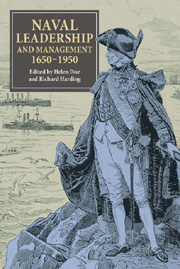Book contents
- Frontmatter
- Contents
- List of Tables
- List of Editors and Contributors
- Acknowledgements
- List of Abbreviations
- Michael Duffy: An Appreciation
- Introduction
- Leadership: The Place of the Hero
- 1 Admiral Rainier's Management Challenges, 1794–1805
- 2 Neglect or Treason: Leadership Failure in the Mid-Eighteenth-Century Royal Navy
- Leadership and Organisational Frictions: Contested Territories
- Management Capability and the Exercise of Naval Power
- The Evolution of Management Training in the Royal Navy, 1800–1950
- Select Bibliography
- Index
1 - Admiral Rainier's Management Challenges, 1794–1805
from Leadership: The Place of the Hero
Published online by Cambridge University Press: 05 February 2013
- Frontmatter
- Contents
- List of Tables
- List of Editors and Contributors
- Acknowledgements
- List of Abbreviations
- Michael Duffy: An Appreciation
- Introduction
- Leadership: The Place of the Hero
- 1 Admiral Rainier's Management Challenges, 1794–1805
- 2 Neglect or Treason: Leadership Failure in the Mid-Eighteenth-Century Royal Navy
- Leadership and Organisational Frictions: Contested Territories
- Management Capability and the Exercise of Naval Power
- The Evolution of Management Training in the Royal Navy, 1800–1950
- Select Bibliography
- Index
Summary
At the end of the eighteenth century the East Indies Command was a junior one, warranting a commodore in peacetime and a rear admiral during times of war. Yet it had two elements which made it unique amongst all the challenges that faced Royal Naval flag officers around the globe. Firstly, there was its enormous size, over 30 million square miles with a journey of 15,000 to 16,000 miles between Britain and the farthest reaches of the station. The time taken for the various routes is explored in the section ‘Communication and Intelligence’ below. But the timing meant that, to all intents, its commander operated independently. The second element was the East India Company, a joint stock company that provided the government for all British possessions in the East Indies, not just India. This organisation provided the navy with all its dockyard facilities and ordnance, many of its naval supplies, and some auxiliary warships and marines.
The purpose of this chapter is to describe how Admiral Peter Rainier, through superior management skills, established an effective organisation which ensured his ships could be at sea for extended periods, and which, continued to be effective as the squadron expanded. Rainier had a reputation as a ‘fighting captain’, earned during the American Revolution, but for the last nine years of his command he saw no shots fired in anger. His reputation therefore rests on his success as the archetypical managerial flag officer which fits the theme of this collection.
- Type
- Chapter
- Information
- Naval Leadership and Management, 1650–1950 , pp. 29 - 42Publisher: Boydell & BrewerPrint publication year: 2012



